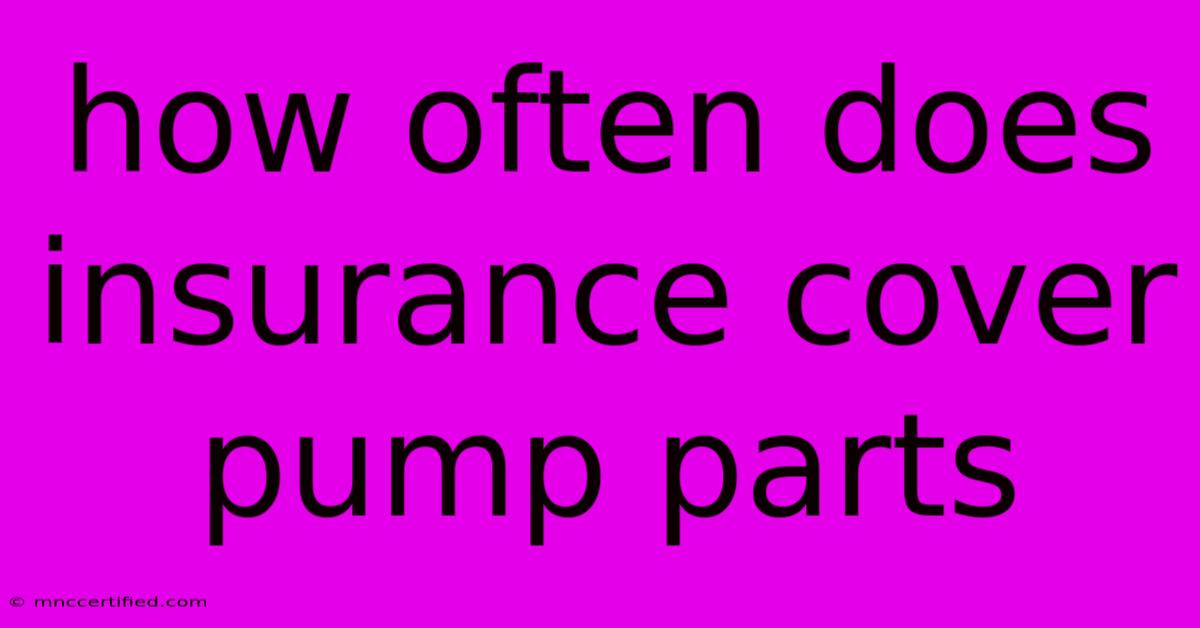How Often Does Insurance Cover Pump Parts

Table of Contents
How Often Does Insurance Cover Pump Parts?
Pump failures can be a costly headache for homeowners, businesses, and even municipalities. When a pump breaks down, it can lead to disruptions in water supply, sewage backup, and even property damage. While homeowners insurance policies often provide some coverage for pump repairs, the details can be complex and vary significantly depending on the specific policy and the cause of the damage.
What Does Insurance Usually Cover?
Homeowners insurance policies generally cover sudden and accidental damage to pumps. This means that if a pump malfunctions due to a power surge, a lightning strike, or a foreign object entering the system, the damage may be covered. However, it's important to note that wear and tear is typically excluded from coverage. This means that if a pump fails due to old age or normal use, the repairs will likely fall outside of the policy's scope.
What About Pump Maintenance?
Most insurance policies do not cover routine maintenance or preventative repairs. This includes tasks like:
- Regular cleaning and lubrication
- Replacing worn-out parts
- Inspecting and adjusting pump settings
When Does Insurance Cover Pump Parts?
Here are some scenarios where insurance may cover pump parts:
- Natural disasters: Hurricane damage, floods, earthquakes, or tornadoes can cause significant damage to pumps. In such cases, insurance will often cover repairs or replacement.
- Sudden and accidental malfunctions: If a pump fails due to a sudden power surge, a malfunctioning electrical component, or a foreign object entering the system, the damage may be covered.
- Manufacturing defects: If a pump fails due to a manufacturing defect, the manufacturer may be liable for repairs or replacement. However, the homeowner's insurance may cover costs related to temporary solutions until the manufacturer resolves the issue.
Factors That Impact Coverage:
- Type of pump: Insurance coverage may vary depending on the type of pump, such as a sump pump, well pump, or pool pump.
- Policy limits: Most insurance policies have limits on the amount of coverage available for specific events.
- Deductible: You will need to pay your deductible before the insurance policy kicks in.
- Policy exclusions: Be sure to review your policy for any specific exclusions related to pump damage.
What Can You Do to Protect Yourself?
- Regular maintenance: Routine maintenance can help prevent pump failures and reduce the risk of costly repairs.
- Consider a separate pump warranty: Some manufacturers offer extended warranties that can cover repairs or replacement beyond the standard warranty period.
- Review your insurance policy: Understand your policy's coverage limits and exclusions before a pump failure occurs.
Conclusion
Understanding the complexities of insurance coverage for pump parts can help homeowners avoid costly surprises. While insurance can provide protection against sudden and accidental damage, it's crucial to remember that routine maintenance and preventative measures are essential for avoiding costly repairs.

Thank you for visiting our website wich cover about How Often Does Insurance Cover Pump Parts. We hope the information provided has been useful to you. Feel free to contact us if you have any questions or need further assistance. See you next time and dont miss to bookmark.
Featured Posts
-
Insurance Companies That Cover Wood Stoves
Nov 07, 2024
-
Savannah Bond Luna Star Yw7ljp41 Onlyfans
Nov 07, 2024
-
Volcanic Eruption Claims 10 Lives In Indonesia
Nov 07, 2024
-
Village Auto Insurance Claims Phone Number
Nov 07, 2024
-
Lawyer Sues Insurance Company Over Cigars
Nov 07, 2024